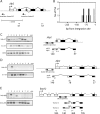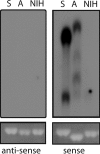Antisense transcription in gammaretroviruses as a mechanism of insertional activation of host genes
- PMID: 20130045
- PMCID: PMC2849499
- DOI: 10.1128/JVI.02088-09
Antisense transcription in gammaretroviruses as a mechanism of insertional activation of host genes
Abstract
Transcription of retroviruses is initiated at the U3-R region boundary in the integrated provirus and continues unidirectionally to produce genomic and mRNA products of positive polarity. Several studies have recently demonstrated the existence of naturally occurring protein-encoding transcripts of negative polarity in complex retroviruses. We report here on the identification of transcripts of negative polarity in simple murine leukemia virus (MLV). In T-cell and B-cell lymphomas induced by SL3-3 and Akv MLV, antisense transcripts initiated in the U3 region of the proviral 5' long terminal repeat (LTR) and continued into the cellular proto-oncogenes Jdp2 and Bach2 to create chimeric transcripts consisting of viral and host sequence. The phenomenon was validated in vivo using a knock-in mouse model homozygous for a single LTR at a position known to activate Nras in B-cell lymphomas. A 5' rapid amplification of cDNA ends (RACE) analysis indicated a broad spectrum of initiation sites within the U3 region of the 5' LTR. Our data show for the first time transcriptional activity of negative polarity initiating in the U3 region of simple retroviruses and suggest a novel mechanism of insertional activation of host genes. Elucidation of the nature and potential regulatory role of 5' LTR antisense transcription will be relevant to the design of therapeutic vectors and may contribute to the increasing recognition of pervasive eukaryotic transcription.
Figures




References
-
- Birney, E., J. A. Stamatoyannopoulos, A. Dutta, R. Guigo, T. R. Gingeras, E. H. Margulies, Z. Weng, M. Snyder, E. T. Dermitzakis, R. E. Thurman, M. S. Kuehn, C. M. Taylor, S. Neph, C. M. Koch, S. Asthana, A. Malhotra, I. Adzhubei, J. A. Greenbaum, R. M. Andrews, P. Flicek, P. J. Boyle, H. Cao, N. P. Carter, G. K. Clelland, S. Davis, N. Day, P. Dhami, S. C. Dillon, M. O. Dorschner, H. Fiegler, P. G. Giresi, J. Goldy, M. Hawrylycz, A. Haydock, R. Humbert, K. D. James, B. E. Johnson, E. M. Johnson, T. T. Frum, E. R. Rosenzweig, N. Karnani, K. Lee, G. C. Lefebvre, P. A. Navas, F. Neri, S. C. Parker, P. J. Sabo, R. Sandstrom, A. Shafer, D. Vetrie, M. Weaver, S. Wilcox, M. Yu, F. S. Collins, J. Dekker, J. D. Lieb, T. D. Tullius, G. E. Crawford, S. Sunyaev, W. S. Noble, I. Dunham, F. Denoeud, A. Reymond, P. Kapranov, J. Rozowsky, D. Zheng, R. Castelo, A. Frankish, J. Harrow, S. Ghosh, A. Sandelin, I. L. Hofacker, R. Baertsch, D. Keefe, S. Dike, J. Cheng, H. A. Hirsch, E. A. Sekinger, J. Lagarde, J. F. Abril, A. Shahab, C. Flamm, C. Fried, J. Hackermuller, J. Hertel, M. Lindemeyer, K. Missal, A. Tanzer, S. Washietl, J. Korbel, O. Emanuelsson, J. S. Pedersen, N. Holroyd, R. Taylor, D. Swarbreck, N. Matthews, M. C. Dickson, D. J. Thomas, M. T. Weirauch, J. Gilbert, et al. 2007. Identification and analysis of functional elements in 1% of the human genome by the ENCODE pilot project. Nature 447:799-816. - PMC - PubMed
Publication types
MeSH terms
Substances
Grants and funding
LinkOut - more resources
Full Text Sources
Miscellaneous

